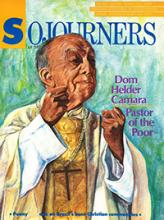"Are you still sleeping? Enough! The hour has arrived!" ( Mark 14:41).
In this last of our studies in Mark's gospel, we arrive at the tragic denouement, and surprise ending, of the story. Known in the church as the passion narrative, it is an intensely political drama, filled with conspiratorial back-room deals and covert action, judicial manipulation and prisoner exchanges, torture and summary execution.
Unfortunately, these raw themes tend to be suppressed by our traditional theological interpretations and pious liturgical reproductions of Holy Week—perhaps because these themes are so uncomfortably persistent in the political culture of our modern national security states. Yet we cannot understand the hope this story bears unless we come to terms with its tragedy.
Here Mark's double plotline converges. On the one hand, Jesus' alienation from the authorities, who strenuously oppose his kingdom practice of justice and compassion, reaches its consequence: arrest. On the other, the inability of Jesus' own disciples to understand and embrace his way—a crisis Mark equates with "blindness"—reaches its logical conclusion: desertion.
Read the Full Article

